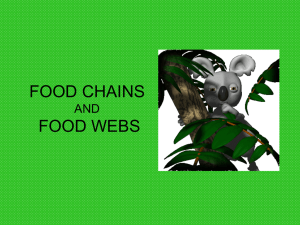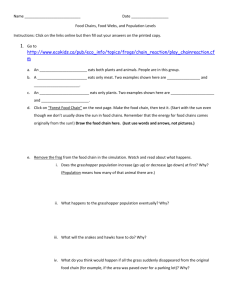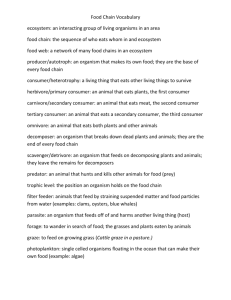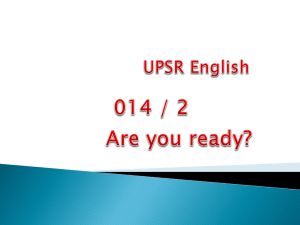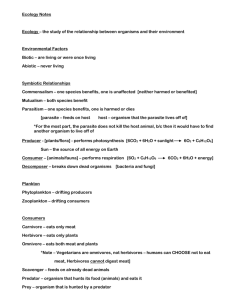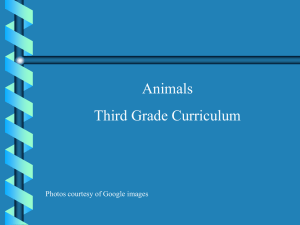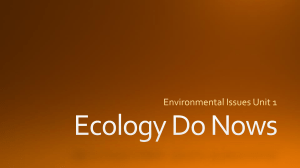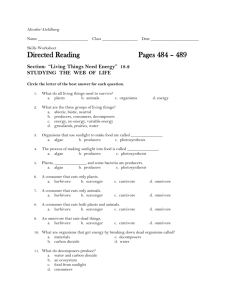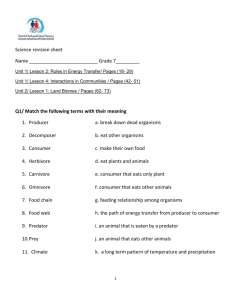Animals Unit Vocabulary Study Guide Standard 3.4 Behavioral and
advertisement
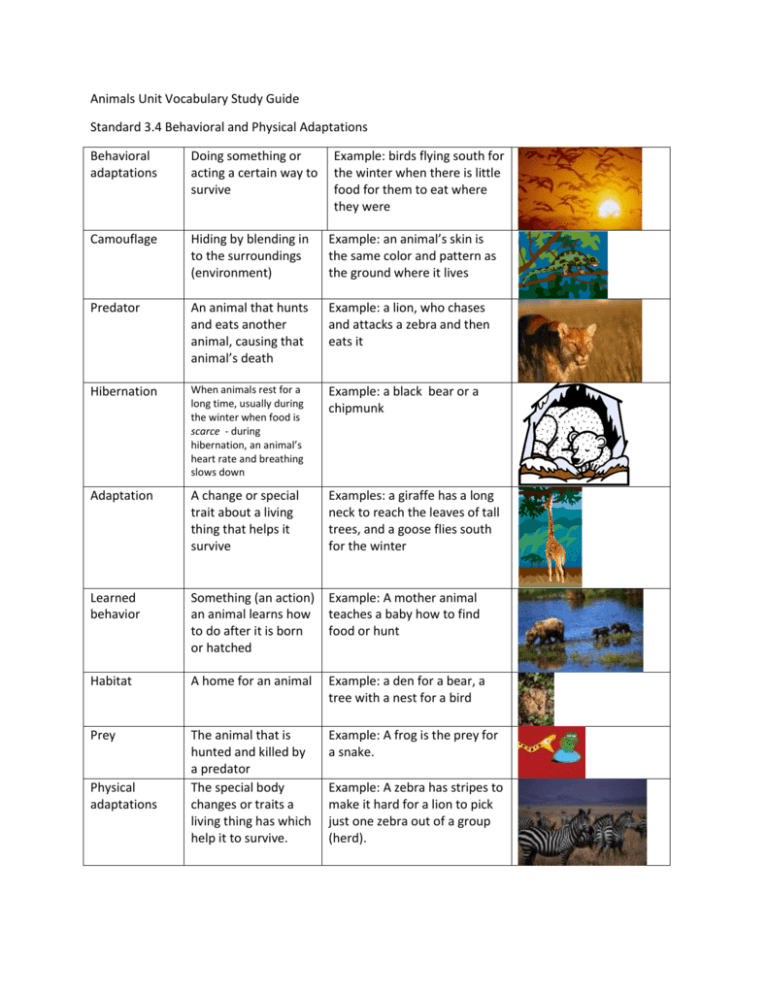
Animals Unit Vocabulary Study Guide Standard 3.4 Behavioral and Physical Adaptations Behavioral adaptations Doing something or acting a certain way to survive Camouflage Hiding by blending in to the surroundings (environment) Example: an animal’s skin is the same color and pattern as the ground where it lives Predator An animal that hunts and eats another animal, causing that animal’s death Example: a lion, who chases and attacks a zebra and then eats it Hibernation When animals rest for a long time, usually during the winter when food is scarce - during hibernation, an animal’s heart rate and breathing slows down Example: a black bear or a chipmunk Adaptation A change or special trait about a living thing that helps it survive Examples: a giraffe has a long neck to reach the leaves of tall trees, and a goose flies south for the winter Learned behavior Something (an action) an animal learns how to do after it is born or hatched Example: A mother animal teaches a baby how to find food or hunt Habitat A home for an animal Example: a den for a bear, a tree with a nest for a bird Prey The animal that is hunted and killed by a predator The special body changes or traits a living thing has which help it to survive. Example: A frog is the prey for a snake. Physical adaptations Example: birds flying south for the winter when there is little food for them to eat where they were Example: A zebra has stripes to make it hard for a lion to pick just one zebra out of a group (herd). Mimicry When a living thing looks like another living thing to trick its predators or prey Example: Some moths have spots which look like big eyes so they can trick their predators. Migration When an animal moves from one location (place) to another so it will be easier to survive. Example: Many animals, like caribou migrate to get more food as the weather changes. Dormancy An amount (a period) of time when a living thing rests, and does not grow or change. Example: Deciduous trees are dormant in the winter. They do not grow new leaves or flowers, or make food. Instinct Something an animal is able to do, or understands, without having to be taught Example: a fish knows to swim and a bird knows to peck by instinct. A dog knows how to bark. Standard 3.5 Life Systems Producer A living thing that makes its own food from nonliving things (sun, water, air). Example: plants and algae (lots of algae together make kelp forests) Consumer A living thing which gets the energy it needs to live eating other living things Decomposer A living thing which gets the energy it needs to live by breaking down a dead animal and plant into the smallest pieces (turns it into the nutrients in soil). This is Example: a bird who eats a worm is a consumer, as is a bird who eats a berry Examples: Fungi (like a mushroom) and bacteria (which are too small to see without a microscope) different from a consumer like a scavenger, (who eats dead animals), because a scavenger’s body will create waste (scat) which is NOT in the smallest pieces. Decomposers will then have to eat the scat to turn it into soil nutrients. Herbivore A living thing which eats producers (plants and algae) to get the energy it needs to survive (remember that an herbivore can eat ANY PART of the plant – seed, nut, flower, leaf, root, stem, fruit) Carnivore A living thing that gets the energy it needs to live by eating other animals (this includes eating bugs, because bugs are animals) Example: cows, deer, sea urchins (they eat kelp, which is algae), rabbits, ducks, honeybees, stinkbugs Example: birds who eat only bugs, lions, foxes, sharks, penguins, owls, spiders Ladybug eating aphid Omnivore A living thing which gets the energy it needs to survive by eating plants or algae AND other animals Example: most humans (people), many birds, monkeys, black bears Organisms A living thing that can grow and change, reproduce (make more of itself), get energy by making it or eating something, and can react to things around it (like plants can learn toward the sunlight, mold moves toward food and water, a sea anemone can sting animals that try to eat it, and lots of animals can use their senses and also move) Food relationship Energy transfer “Who eats what” Living things (organisms) are connected to each other by how they get the energy they need to survive. That connection can be called a relationship. Energy gets passed from one organism to another as each organism is “eaten” by another. Plants and algae make sugars inside themselves (from the air, sun and water). Producers use their own sugar energy to live. Some of their sugar energy gets passed to the herbivore which eats the plant. A lot of the energy gets used by the herbivore to keep it alive. A little bit of the energy is left and gets passed to the omnivore or carnivore that eats the herbivore. The omnivore or carnivore uses most of this energy to live. Some of this energy is left, and is passed to the decomposer which breaks down the waste or dead body of the omnivore or carnivore. The energy is finally used up. Example: a plant, a bug, a human, a shrimp, algae, bacteria, a mushroom, mold, cat, bird Example: food chains and webs See below See below Example: An apple tree uses sunlight, air and water to make sugars inside its leaves. The apple tree uses a lot of this sugar energy to stay alive, grow, and make apples. A deer eats an apple, which has sugar energy in it. The deer’s body uses the energy, but some is left and is passed on to the mountain lion who eats the deer. The mountain lion grows old and dies, and decomposers use the rest of the energy to feed themselves. The waste of the decomposer puts little nutrients back into the soil – but these nutrients are not sugar energy. The plants use these little nutrients (minerals) to change the sun’s energy into sugar energy. They also use these little minerals to grow, change, and even “eat” their own sugar energy. Energy transfer can be shown as an energy pyramid Food chain A picture, or diagram which shows “who eats what” The arrows show which way the nutrients and energy go. Example: see right Food web A picture or diagram which shows “who eats what” when more than one organism eats more than one food Follow the arrows to see the multiple animals which eat each organism. Example: see right See that the Grasses are eaten by the Artic Hare, the Lemming, the Musk Ox, AND the Caribou. See that the Artic Hare is eaten by the Hawk, the Polar Bear, AND the Wolf. Food Chain Food Web Standard 3.8b Earth Patterns, Cycles, and Change Cycle A series (or more than one thing in order) that repeats It happens in the same order each time, and the end starts the beginning! Life cycle A cycle that shows how an organism begins its life, then grows and changes, then reproduces to start the cycle again. It must be in order. Example: The school year occurs in a cycle. You begin school, you get a 1st quarter report card, then a 2nd quarter report card, then a 3rd quarter report card, then a 4th quarter report card, then you have a summer break, then you start all over again! Examples: A plant life cycle, a butterfly life cycle, a frog life cycle, and a bird life cycle Cycles are often shown with a diagram or picture Butterfly Life Cycle Frog Life Cycle Pattern An observed repeating order of the way something looks, or the way something behaves Examples: anything that happens in the same order over and over again, like the seasons Relationship A connection between two or more things – one affects the other in some way Examples: an owl and a mouse have a predator/prey relationship There is a relationship between the number of trees and plants and the amount of pollution which reaches the Chesapeake Bay. Example: There is a sequence of events to brush your teeth. Can you describe it? Sequence Order of events Patterns can be observed as connections between two or more events (things that happen) by looking at data such as tables, graphs, and charts. What patterns can you see in this line graph? There is a relationship between the landscape and water pollution. Standard 3.10 a,b,c Earth Resources and Human Influence Interdependency Two or more things relying on each other, or affecting each other in some way Conservation Saving something Extinct When there are no more of a certain type of organism living on the earth Species A certain type of organism When a species is IN DANGER of going extinct very soon – there are not very many left Example: red panda, clown fish Example: Bengal Tiger When the population of a species is declining (going down, or getting smaller) and that species might become endangered soon Example: Polar Bear Endangered Threatened Example: The clown fish and the sea anemone are interdependent. The clown fish scares away small fish, and leaves little bits of food for the sea anemone after it eats. The sea anemone provides (gives) the clown fish a place to hide from predators. Example: If you practice (do) water conservation, you turn off the water while brushing your teeth. Example: dinosaurs are now extinct The Thylacine, or Tasmanian Tiger is now extinct.
